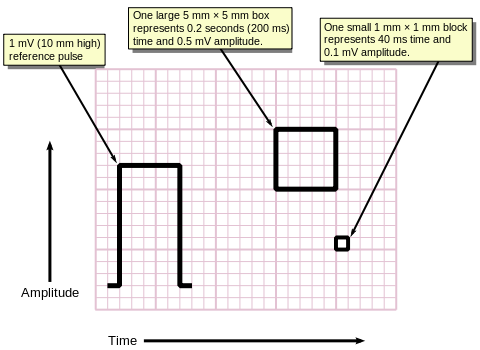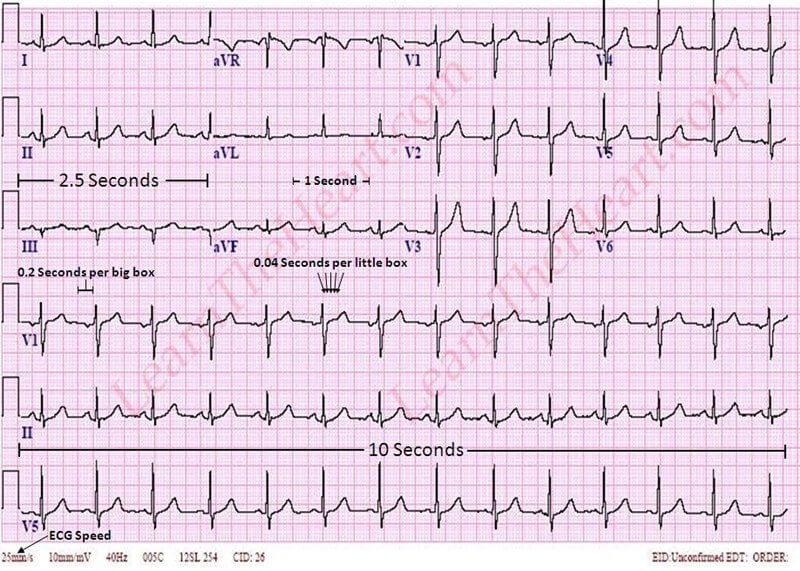ECG Boxes To Seconds Calculator is used for converting the length and distance of intervals in ECG boxes to their durations expressed in seconds or milliseconds. You can do the conversion for any number and different types of boxes and the paper speed of the ECG machine.
Check out this category if you need more health-related calculators besides ECG Boxes To Seconds Calculator. Further, if you are interested in finances, then check this category where you can calculate Commission or Profit using our calculators.
ECG – Definition
An electrocardiogram or ECG is a type of test that is used to evaluate the heart by placing electrodes at certain spots on the chest, arms, and legs. Then, we connect electrodes to the ECG machine through lead wires. Any electrical activity of the heart detected is measured and displayed on the screen. An electrocardiogram records the electrical activity and measures the speed of the heart’s beating, the rhythm, and electrical impulses’ strength and timing. Any change you notice in ECG may indicate the change in an individual’s heart state.

So, what is an ECG Box?
ECG Box is a measurement unit used in ECG for measuring time and distance. For example, every ECG consists of large and small squares. One large box equals 0.20 seconds, whereas one small box equals 0.04 seconds or a five times smaller value.
ECG Boxes To Seconds Conversion – Formula
When it comes to the length of ECG boxes, a small box measures 1 mm, while a big box 5 mm. Their duration depends on the paper set’s speed in the ECG machine, which is 25 mm/s normally.
If you would like to convert ECG boxes to seconds/milliseconds, there are some parameters you need to take into account:
- number of boxes (value)
- type of box (small or big)
- paper speed (25 or 50 mm/s)
Therefore, once you have determined those parameters, you can easily convert ECG boxes to seconds using our calculator.
Note: There is a universal formula for the conversion, but as we said, it doesn’t give you 100% correct result because it doesn’t consider all the key parameters:
\text{Duration of a measured distance = Number of Squares x Duration of a box}Normal ECG values for waves and intervals
Here is the list of the normal ECG values for waves and intervals:
| Wave/Interval | ECG Value |
| P wave | 80 milliseconds |
| PR interval | 120-200 milliseconds |
| QRS complex | 80-100 milliseconds |
| ST-segment | 80-120 milliseconds |
| T wave | 160 milliseconds |
| ST interval | 320 milliseconds |
| QT interval | should be corrected for a heart rate of a patient |
ECG and PR Interval
PR Interval is called a period in the ECG from the depolarization of atria (P wave) to the beginning of the QRS complex. Medical professionals often use ECG to early spot some pathologies of the heart.
Measuring PR interval
When measuring PR interval, there is something you need to know beforehand:
- Normal PR interval between 0.12-0.20 seconds equals 3 to 5 small squares on the EKG strip
- You always start measuring first, going from the beginning of the P-wave all the way until the beginning of the QRS complex
Steps to measure PR Interval:
- Locate and find the P-wave on the EKG strip
- To find the PR Interval, first, go from the beginning of the P-wave until the beginning of the QRS complex
- See how many squares you have between them
- Each square is equivalent to 0.04s, so if you, for example, count three squares, the PR Interval equals 0.12s
ECG Rate Interpretation
We already mentioned that each ECG uses small and large squares to measure distance and time. Small squares equal 0.04s, whereas large squares equal five times more, each 0.20s.

Suppose the whole ECG equals 10 seconds in total; we already know that there are 10 / 0.2s for each large box = 50 large boxes. Additionally, if we consider the fact that each small box has a length of 1 mm, then one large box equals 1 x 5 = 5 mm. Therefore, the general rule for choosing the measurement unit is:
- If we measure the amplitudes of waves or complexes, we always use millimeters (mm).
- If we measure an interval’s length, we use seconds or milliseconds.
QRS complex and QT interval
Besides analyzing other waves and PR Interval, ECG also measures the duration of Q-T interval and QRS.
Q-T interval represents the time that the electrical system needs to fire an impulse through the ventricles and then recharge. In other words, it equals the time it takes for the heart muscle to contract and then recover.
If the duration of the QRS is long, it leads to a “wide QRS complex”. It is mainly caused by:
- Hyperkaliemia
- Ventricular tachycardia
- Idioventricular rhythm
- Wolf-Parkinson-White syndrome
- Premature ventricular contraction
ECG Boxes To Seconds Calculator – How to Use?
Okay, you learned the formula for converting ECG Boxes to Seconds, but is this the right approach? Not really, because there are some parameters that you need to include to get the correct result. Don’t worry because our calculator comes with all of that, and you just need to enter the values. Let me show you below:
Steps:
- Determine the number of squares (distance in electrocardiogram) and enter it into the calculator
- Select the type of boxes (small or large)
- Choose the paper speed of the ECG machine (the standard 25 mm/s or 50 mm/s)
- Our calculator will take your input and give you the duration of the measured distance in seconds or milliseconds.
FAQ
How many boxes on ECG is a second?
A second of the duration of the measured distance in electrocardiogram equals 5 large or 25 small boxes.
How many squares are 3 seconds on ECG?
3 seconds of duration = 1 second (5 squares) x 3 = 5 x 3 = 15 squares
How do you calculate heart rate from ECG?
We can easily calculate heart rate from the ECG strip using one of the following methods:
– If the rhythm is regular, we calculate heart rate by taking the value of 300 and dividing it by the number of squares between the QPS complexes. For instance, suppose there are 5 large squares between the complexes, then the heart rate is 300 / 5 = 60
– The second method for calculating the heart rate is if the rhythm is irregular. You need to multiply how many R waves you have in a six-second strip by 10. For instance, we counted 8 R waves; the heart rate would be 8 x 10 = 80
What is a normal ECG rate?
A normal ECG rate (bpm) is considered between 60 – 100 beats per minute, optimally 82 bpm.
